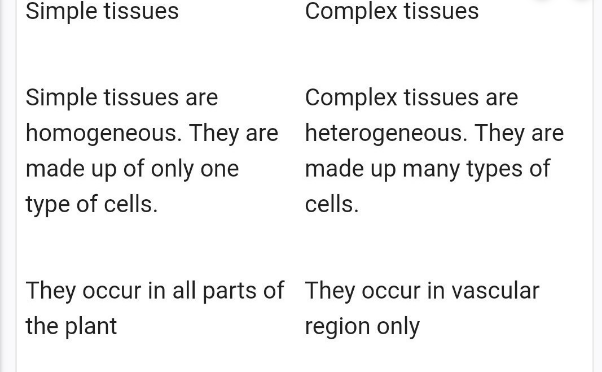What is Difference Between Simple And Complex Tissue?
Difference Between Simple And Complex Tissue is that The simple permanent tissue is formed by a type of cells while The complex permanent tissue is formed by different types of cells that perform various functions. Examples of simple permanent tissues: parenchyma, collenchyma and sclerenchyma. Examples of complex permanent tissues: xylem and phloem. In addition, simple permanent tissue is present in all parts of the plant, while complex permanent tissue is mainly present in vascular tissue.

Simple permanent tissue and complex permanent tissue are two types of permanent tissues found in the upper floors. The third type of permanent fabric is specialized permanent fabric. Permanent tissues differ from meristematic tissues. Therefore, cells in permanent tissue have lost their dividing power. Permanent tissue cells have a definite shape and a shape. The main difference between simple permanent tissue and complex permanent tissue is that simple permanent tissue consists of similar types of cells that perform similar functions, while permanent complex tissue consists of several cells that perform various functions within the tissue.
What is simple permanent tissue?
Simple permanent tissue is a type of permanent tissue, which is composed of homogeneous cells with similar functions. Three types of simple permanent tissues are found: parenchyma, collenchyma and sclerenchyma.
Parenchyma
The most common type of simple permanent tissue is the parenchyma. The parenchyma consists of non-specialized cells, and they can be found in the cortex, the pericycle, the epidermis, and the medulla. The main functions of the parenchyma are photosynthesis, food storage, and secretion.
Collenchyma
The colénquima is a type of simple and permanent tissue that is located under the epidermis. Collenchyma cells are living cells. They consist of a few chloroplasts to perform photosynthesis.
Sclerenchyma
The sclerenchyma consists of thick and elongated wall cells. The decreasing ends of the sclerenchyma cells are lignified. Therefore, sclerenchyma cells are dead cells that provide structural support to the plant.
What is complex permanent tissue?
Complex permanent tissue is another type of permanent tissue, which is composed of several types of cells that perform various functions. The two types of complex permanent tissue are the xylem and the phloem.
Xylem
The xylem is the complex permanent tissue that is involved in the conduction of water and minerals from the roots to the leaves of the plant. The xylem comprises four types of cells; vessels, tracheids, xylem fibers, and xylem parenchyma. Ships are tube-shaped cells with a wide central lumen and lignified walls. The main function of ships is to conduct water and minerals. The vessels also provide structural support. Tracheids These are elongated cells with densely lignified cell walls. Xylem fibers They are pointed cells at their ends. Tracheids and xylem fibers also conduct water from the roots to the leaves and provide structural support. Parenchyma xilemStore fatty acids and starch.
Bast
Phloem is a type of permanent complex tissue that participates in the conduction of leaf nutrients throughout the plant’s body. The four types of cells in the phloem are sieve cells, companion cells, phloem fibers, and phloem parenchyma. Sieve cells These are elongated cells, which contain sieve plates at each end. Company cells Stick to the sidewalls of the sieve cells. Phloem fibers are a type of sclerenchyma cells, which provide structural support to the plant. The parenchyma of phloem food stores.
Similarities between simple permanent tissue and complex permanent tissue
- Simple permanent tissue and complex permanent tissue are two types of permanent tissues found in the upper floors.
- Both types of permanent tissue types are composed of living and non-living cells.
- Cells in both types of tissues have similar origins.
Difference between simple permanent tissue and complex permanent tissue
Definition
Simple permanent tissue: The simple permanent tissue is a group of cells with similar origins, structures, and functions.
Complex permanent tissue: The complex permanent tissue is a group of cells with several types of cells that have the same origin but different functions. However, cells in complex tissue work as a unit.
Idea
Simple permanent fabric: The simple permanent fabric is found in each part of the plant.
Complex permanent tissue: Complex permanent tissues are found in the vascular regions of the plant.
Tissue cell types
Simple permanent tissue: The simple permanent tissue is composed of one type of cell.
Complex permanent tissue: The complex permanent tissue is composed of several types of cells.
Functions of cells in the tissue.
Simple permanent tissue: All cells in the simple permanent tissue perform the same function.
Complex permanent tissue: Different types of cells in the complex permanent tissue perform different goals.
Function
Simple permanent tissue: Photosynthesis, food storage, tissue repair, and secretion are the main functions of simple permanent tissues.
Complex permanent tissue: Structural support, water, and nutrient conduction and protection against hydration are major functions of complex permanent tissue.
Examples
Simple permanent tissue: The collenchyma, the parenchyma, and the sclerenchyma are the three types of simple permanent tissues.
Complex permanent tissue: The xylem and phloem are the two types of complex permanent tissues.
conclusion
Simple permanent tissue and complex permanent tissue are two types of permanent tissues found in the upper floors. Simple permanent tissues are composed of the same type of cells that perform the same function. In contrast, complex permanent tissues are composed of several types of cells, and each type of cell performs a diverse function. Parenchyma, collenchyma and sclerenchyma are the three types of simple permanent tissues. Xylem and phloem are the two types of complex permanent tissues. The main difference between simple permanent tissue and complex permanent tissue is the type of cells and their functions in the plant body.
You May Also Interested:
